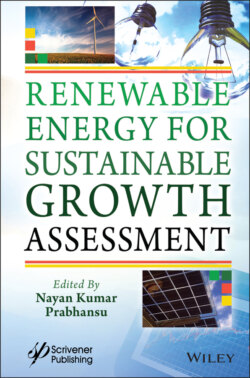Читать книгу Renewable Energy for Sustainable Growth Assessment - Группа авторов - Страница 77
3.3.1.3 Micro and Macroalgal Biomass (Third-Generation - 3G)
ОглавлениеMicro and macroalgae (third-generation (3G) feedstock) are a possible alternative source of sustainable energy production because they do not need food and fresh water to survive (Table 3.3). The goal has now been to commercialize algal biomass to manufacture biofuels and supplements for cosmetics, medicines, and wastewater treatment [40]. The limitation of 3G feedstock is that fermentable sugars are not yielded directly without pretreatment.
Microalgae belong to phytoplankton, a broad genus of plant and Photosynthetic organisms [49, 50]. The wastewater toxins can be removed easily by them. The processing of ethanol from microalgae biomass became a promising source that a decreased environmental effect, with an adequate fixation of CO2 and requiring less arable land [44] and generated bioethanol. Moncada et al. [51] were the first to combine molasses (first-generation feedstock) and microalgal biomass substrates (third-generation feedstock) for the production of ethanol (Table 3.3). This research suggested that sugarcane and microalgae integration appears to be profitable. Microwave-assisted heating wet torrefaction for acid pretreatment (Table 3.3) is a feasible green technology for microalgal biorefinery alternative to fossil fuel [41]. Another promising microalgae species, Golenkinia sp, accomplish microalgae-based renewable energy and wastewater treatment [42] (Table 3.3). For the commercial exploitation of microalgal-based biofuels, the use of all components of microalgal biomass is significant. Seaweeds and marine macroalgae contain high concentrations of starch and cellulose in their tissues. The viability of producing feedstock from seaweed (Ulva sp. (Chlorophyta)) in land-based cultivation has potential in terms of bioethanol [46]. Freshwater macroalgae feedstocks are potential for bioenergy generation (Table 3.3). The presence of lipid content of 18.6% in macroalgae biomass suggests that freshwater macroalgae are a possible biodiesel source [47].
Table 3.3 List of third-generation (3G) and fourth-generation (4G) feedstock, the process of conversion, and biofuel products.
| Types of biomass | Biomass | Process of conversion | Biofuel products | Reference |
| Microalgae (third-generation - 3G) | Hydrolysed Spirulina biomass in association with molasses | Acid hydrolysis and magnetic field (MF) application and Fermentation by S. cerevisiae | Bioethanol | [28] |
| Chlorella vulgaris ESP-31 | Microwave-assisted heating wet torrefaction and fermentation by S. cerevisiae | Bioethanol | [41] | |
| Golenkinia sp. SDEC-16 | - | Biodiesel and wastewater treatment | [42] | |
| Scenedesmus sp. CCNM 1077 | Fermentation by S.cerevisiae ATCC 6793 | Bioethanol | [43] | |
| Chlamydomonas reinhardtii and PNS photosynthetic bacteria Rhodobacter capsulatus | - | Bioethanol | [44] | |
| Chlorella vulgaris FSP-E | Dilute acid hydrolysis (1% H2SO4) and fermentation by Zymomonas mobilis | Bioethanol | [45] | |
| Macroalgae (third-generation - 3G) | Ulva sp. (Chlorophyta) | Enzymatic hydrolysis - cellulase, amyloglucosidase, and amylase/ fermentation by Saccharomyces cerevisiae | Bioethanol | [46] |
| Freshwater macroalgae | Lipid extraction by soxhlet extraction method and anaerobic fermentation | Biodiesel and bioethanol | [47] | |
| Genetically engineered biomass (fourth-generation - 4G) | Starch-excess OsSEX4-knockdown transgenic rice straw | Biologically hydrolyzed by Trichoderma reesei and Aspergillus niger/fermented by Zymomonas mobilis – SSF process | Bioethanol | [48] |
